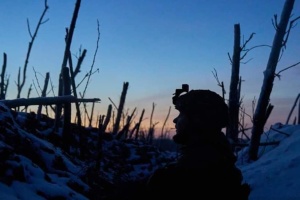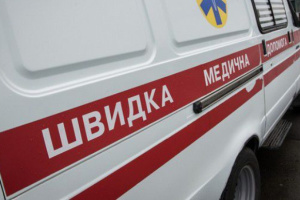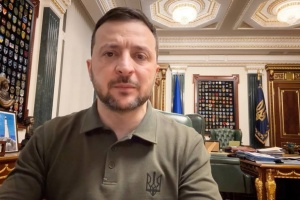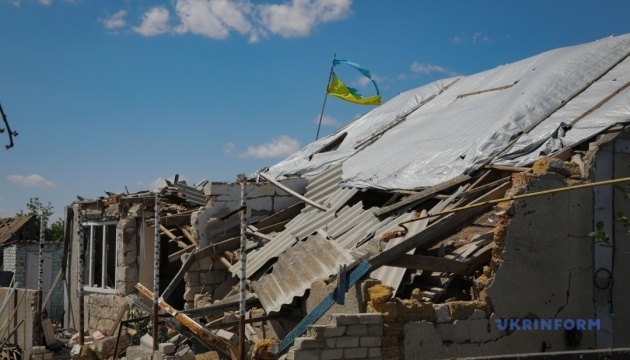
Will there be any life for Blahodatne?
Before the war, it numbered about 350 people. At the beginning of the full-scale invasion, it became a transit point for the Russian invaders attempting to take Mykolaiv by storm and was located in the so-called “gray” zone. Every day residents of Blahodatne would see military convoys moving toward the oblast center. As early as mid-March, the Russians set up a checkpoint on the bridge over the Inhul Canal on the outskirts of the village and started “paying visits” to the locals. Around March 20, 2022, “incoming hits” in Blahodatne began: the Ukrainian military had been maneuvering, trying to push the Russians away from Mykolaiv, so the invaders kept shelling their positions, ignoring the civilians living nearby.
Back then, more than a thousand people still remained in the village — thrice more than before the war, because of the prevailing opinion among city dwellers that the countryside was safer.
There is not a single intact building left in Blahodatne: about 180 residences, a kindergarten, a church, and a village club were destroyed. But in November 2022, after Kherson was de-occupied and the invaders retreated to the Dnipro’s opposite bank, people started coming back to their ruined homes. They would clear the debris and remove unexploded ordnance from the wreckage themselves. At the moment, Blahodatne numbers 26 residents. People begin to build a new life on the wreckage of their old lives.
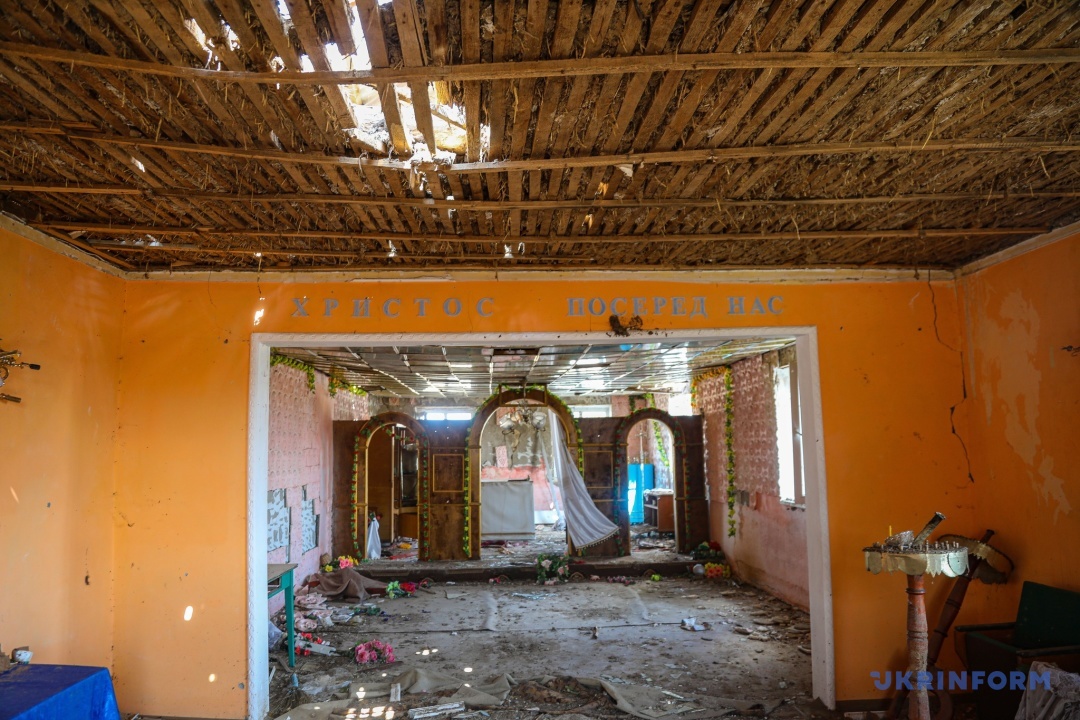
Ukrinform correspondents visited the devastated village and heard stories from the locals about how it was like to lose everything, risking their lives to build a future from scratch.
THE VILLAGE WAS BURNING, BODIES WERE LYING IN THE STREETS
Our journey started in Mykolaiv, where we met our guide Dmytro Yeliseienko. Dmytro was born and lived in Blahodatne before the full-scale invasion. He lost his friends, his home, and then partially lost his sight as well. When Blahodatne was opened for entry in late November 2022, he was among the first to return to the village to help the animals still remaining there.
The road to Blahodatne goes through the neighboring village of Partyzanske. Here, a stretch of land was to be allocated, so that temporary housing could be built for the Blahodatne residents. However, the community was not happy with this idea. Firstly, a pig farm stood on this land in Soviet times, so the soil had accumulated a lot of sewage. Secondly, people believe that in this way the authorities would put the restoration of their Blahodatne off the agenda. Some of the Blahodatne residents, nevertheless, have temporarily settled in Partyzanske at their relatives’ or friends’ houses.
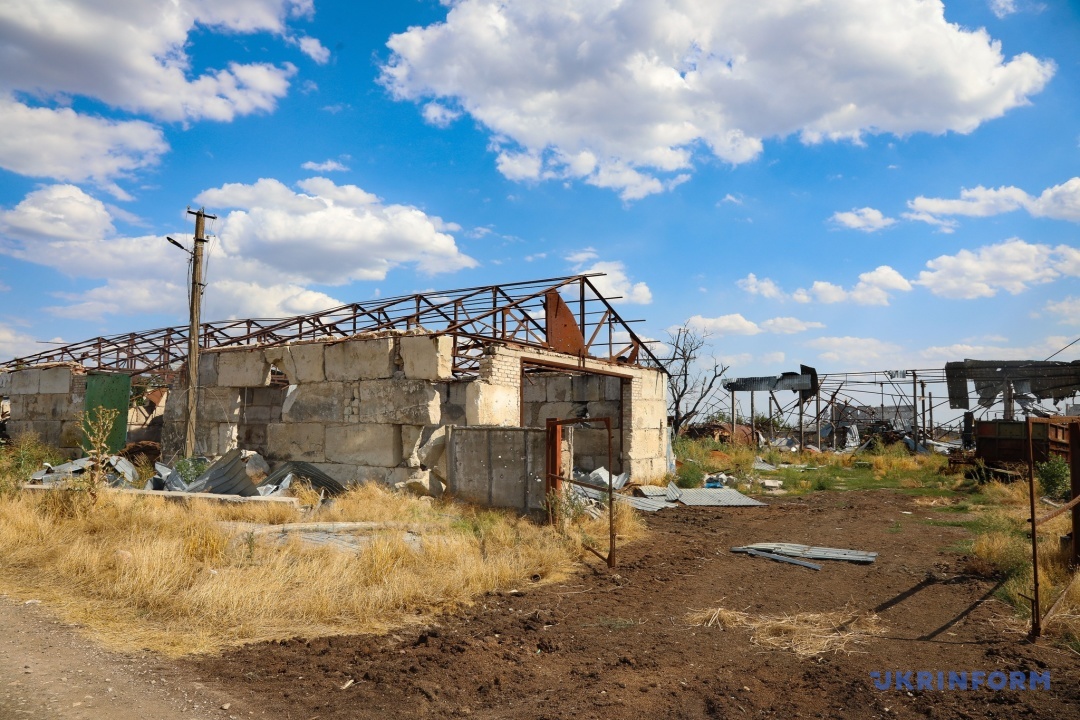
We visit farmer Mykhailo Zveryshyn, a relative of Dmytro’s. He lives in his son’s half-ruined house.
His own house in Blahodatne, along with agricultural machinery and harvested crops, burned down at the beginning of the war. He miraculously survived and helped his neighbors evacuate from under the shelling. Mykhailo cannot hold back his tears when recalling the beginning of the great war.
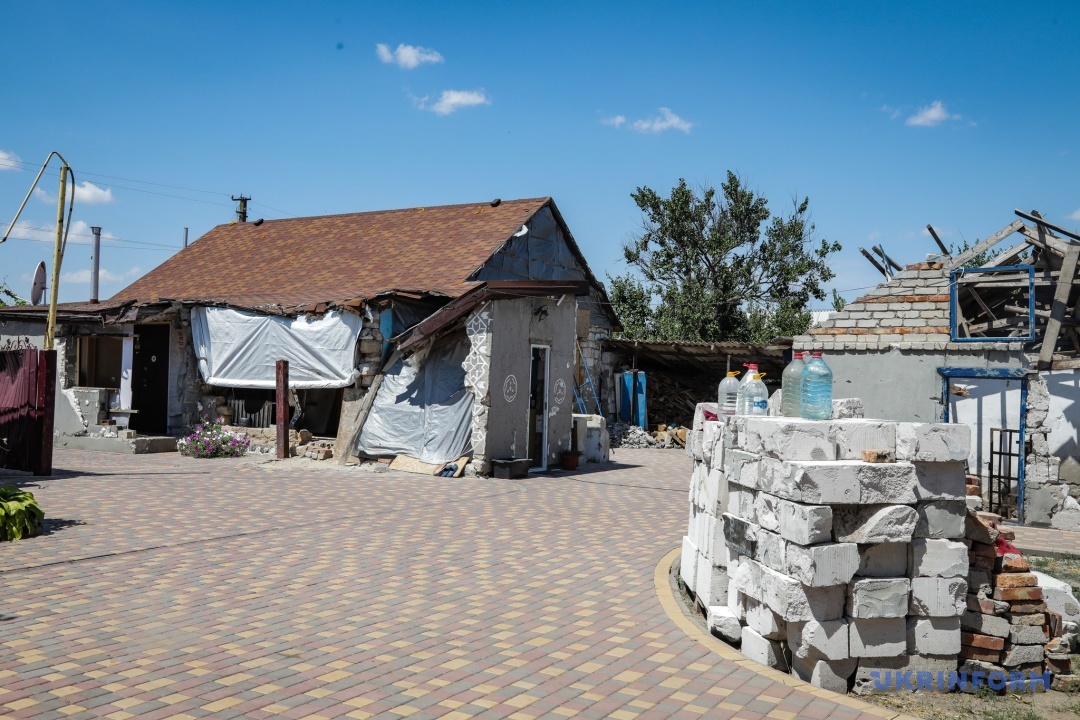
“At first, we were just scared. In Blahodatne, two or three families would gather in a house and live like that. We thought that everything was about to end, that this horror could not last long, that the world was about to respond and put Russia in its place. Our village was not touched, the tanks were driving on toward Mykolaiv. Then the invaders set up a checkpoint on the bridge over the Inhul Canal, but not everyone was allowed to pass through. Those who were considered suspicious for some reason were turned back. They would let me out of the village only if I had a pass: forexample, I could visit my son in Partyzanske for three hours and no more. Russians would also enter the village to scare the locals.
“When our army began to fight back, trying to repulse the Russians, all hell broke loose. The village was literally on fire. I saw the bodies of dead soldiers lying in the streets, both ours and Russians. I saw my friend being torn to pieces by a shell. We lived in the basement for two weeks, waiting for the evacuation. But there was no evacuation. Then, after another merciless shelling, I could not stand it anymore, grabbed my wife and neighbors, packing a car full of people, and drove them out of the village. We escaped in the clothes we were wearing. The car was shelled on the way, but fortunately, we survived,” says Mr. Zveryshyn.
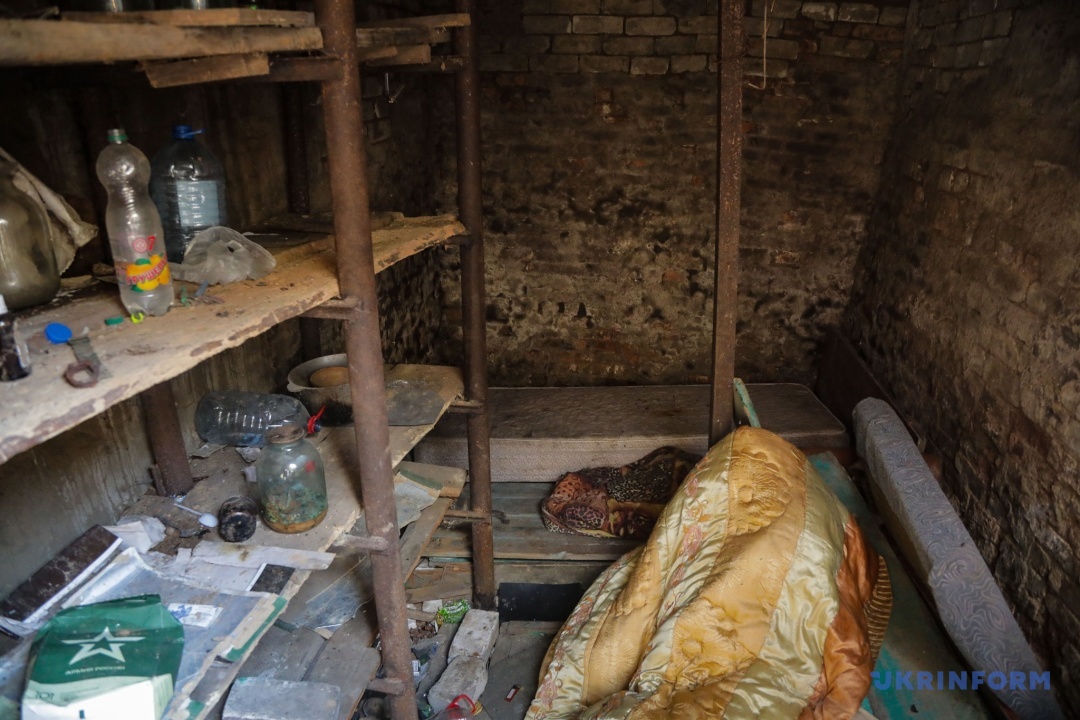
Mr. Zveryshyn has been farming for 50 years. He rose from an ordinary tractor driver to the manager of two farms, Valentyna and Iryna, spread over more than 1,500 hectares of land outside Blahodatne. Now, together with his family, he sows barley and sunflower on his son’s land near Partyzanske.
“We had two combines, both of which were damaged. We went into debt to repair the one that was damaged less. We had six MTZ tractors, but now only two are left. 200 tons of wheat and 250 tons of sunflower seeds were destroyed by the fire. I lost $2.5 million worth of machinery! Today, getting back up is an uphill task… We are in such terrible debt; you can’t even imagine. It’s just me and my son working now, we have no money to pay the workers. We’ve harvested the first 50 tons of barley this year, but cannot sell it. We are waiting for the price to rise at least a little to break even. I’m not even talking about profit,” the farmer continues.
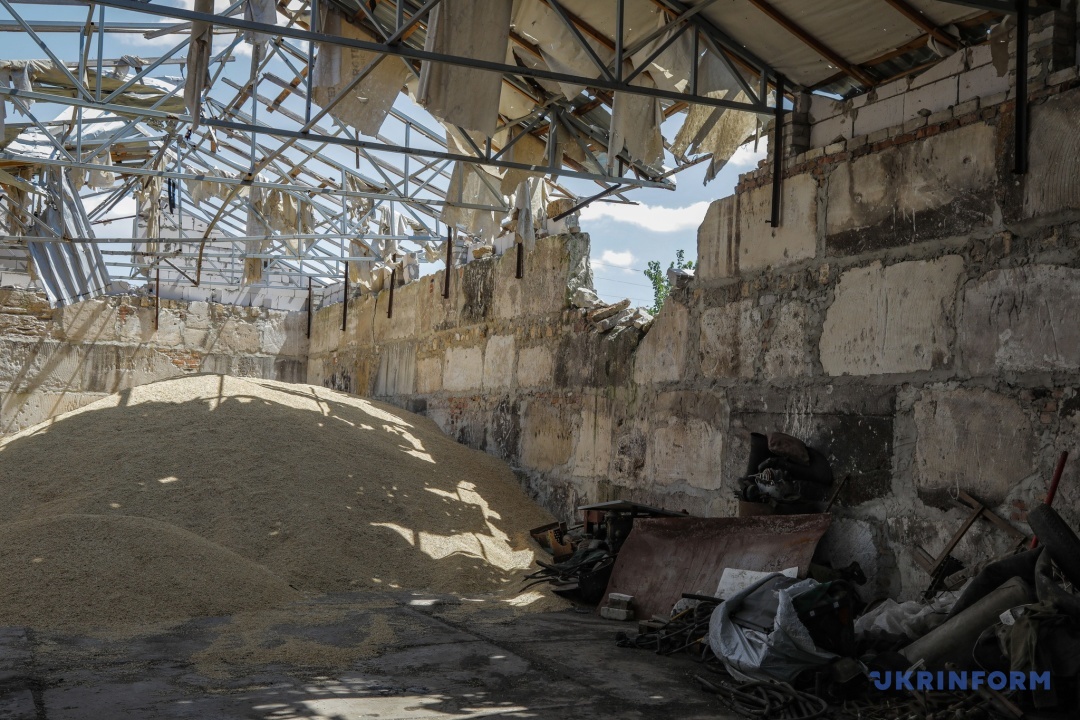
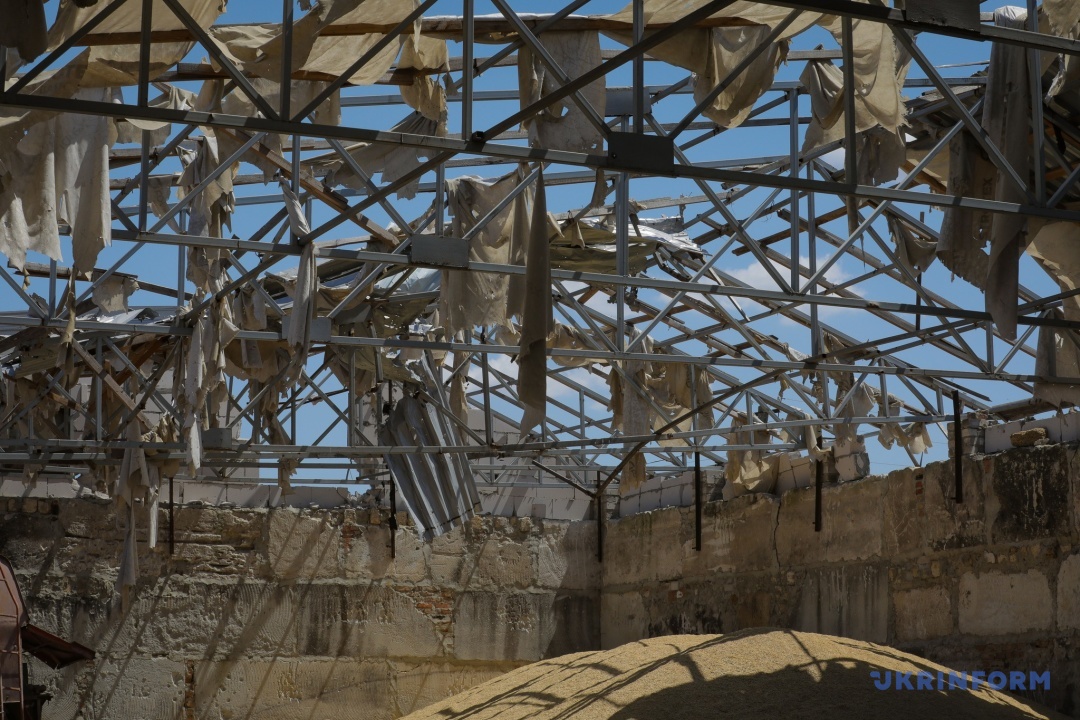
WORKING IS SCARY, BUT WE CAN’T QUIT
I ask Mr. Zveryshyn if he’s not scared to go out into the fields, because no mine clearance has been done there yet. “How can I abandon anything? This is my life! Yes, it’s scary. We were told by the Emergency Service that these fields near Partyzanske had not been mined by the Russians because the village had not been occupied. They suggested that we inspect the fields ourselves and try to find explosives. If we find them, we should contact EOD specialists. That’s what we did. They responded quickly enough, came and took away the missile or whatever was sticking out of the ground. But one day a disaster struck. My relative Dmytro hit a mine while working in the field on a tractor. He survived, but suffered severe eye injuries,” says Mr. Zveryshyn and nods towards our guide.
Dmytro himself is standing near the wreckage of the tractor blown up by the mine in March 2023 during the sowing season.
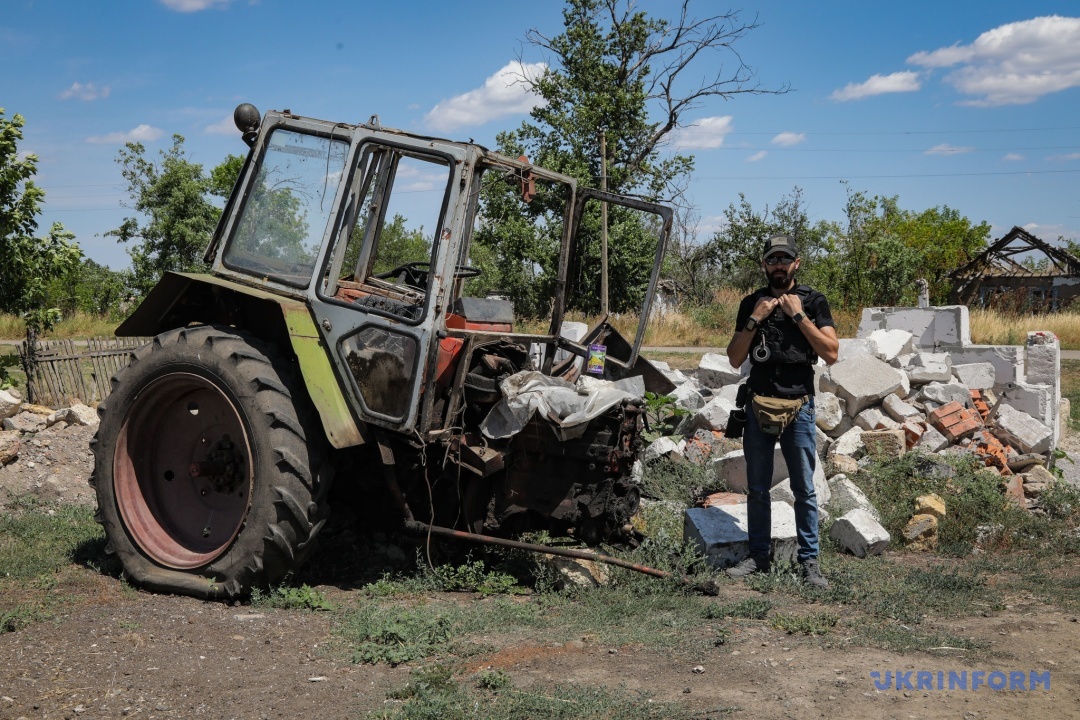
Mr. Zveryshyn goes on to say that he dreams of returning to his native Blahodatne and rebuilding his home. He says that at a recent meeting of the village residents with the authorities, the people of Blahodatne stood up for their homes and are still waiting for the construction of temporary small houses to begin.
“Here, in Partyzanske, the village council provides building materials for repairs, but in Blahodatne there is nothing to repair. Almost all the houses have no walls left. What is there to hang that slate on? They just wanted to demolish our village and move it to a pig farm. And there is a meter of manure in the soil! We won’t let them do that! People were outraged, so they promised us that they would put up temporary, eight-by-four-meter foam concrete block outbuildings. We will live in them and rebuild our homes gradually,” says Mr. Zveryshyn.
We finish the coffee brewed for us by the host and get ready to go to Blahodatne. Dmytro jokes thatwe will have coffee at his place as well. The joke is bitter: there is almost nothing left of his house…
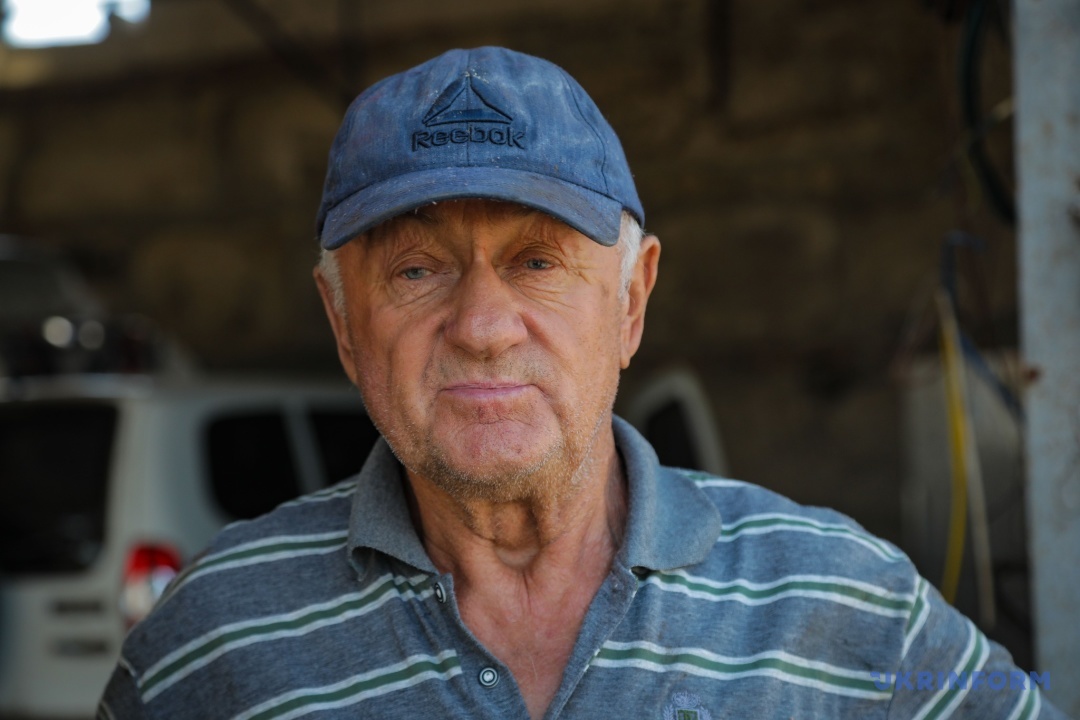
We were getting into the car when a “delegation” of Partyzanske residents approached us. The “Press” sign on the car drew everybody’s attention. Everyone wants to be heard, to tell their horrible story and ask for some help. All the stories are different, but they are all permeated with the same pain of the experienced horrors of war. Everyone is asking for help to rebuild their homes.
WE WILL REBUILD EVERYTHING, JUST HELP US
Viktoriia and her 3-year-old son Ivan returned to Partyzanske in April 2023. She says that theirfamily was lucky because the walls of their ruined house were still intact, so it can be repaired.
According to Viktoriia, volunteers come to the village and bring building materials, such as roof beams and slates.

“They brought us slate. Still, we do not know what to do next. We have the materials, but we can’t cover the roof. It costs 200 hryvnias to nail a single slate, so we need almost 20 thousand hryvnias for our roof. We have to live in a “portacabin” (referring to the tent provided by the village council for six months — H.B.) in the kitchen garden,” says Viktoriia.
It is excruciatingly hot inside the temporary house. Breathing there is almost impossible. According to Viktoriia, the temperature inside reaches 37 degrees on sunny summer days. While in April, says Viktoriia, it was freezing.
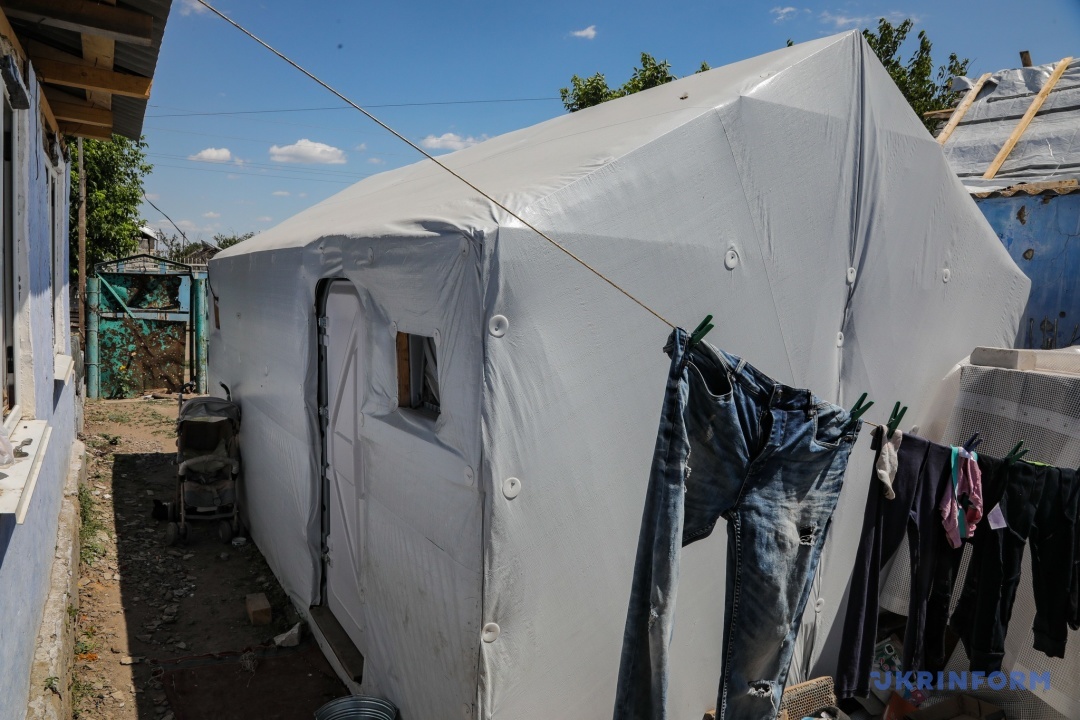
Little Ivan is a little afraid of strangers and runs away to a larger house. We follow the boy. The owners have already cleaned in the house that only has the walls standing.
“You should have seen this house when we returned in April… We arrived just before Easter, on Maundy Thursday. Everything was wet, everything was leaking here… There was rubble as high as my height! We had to clear the debris ourselves… I cried so hard when I saw it, I was on pills for three days! We lived in a shed for a while, and then were given this temporary house,” says Viktoriia.
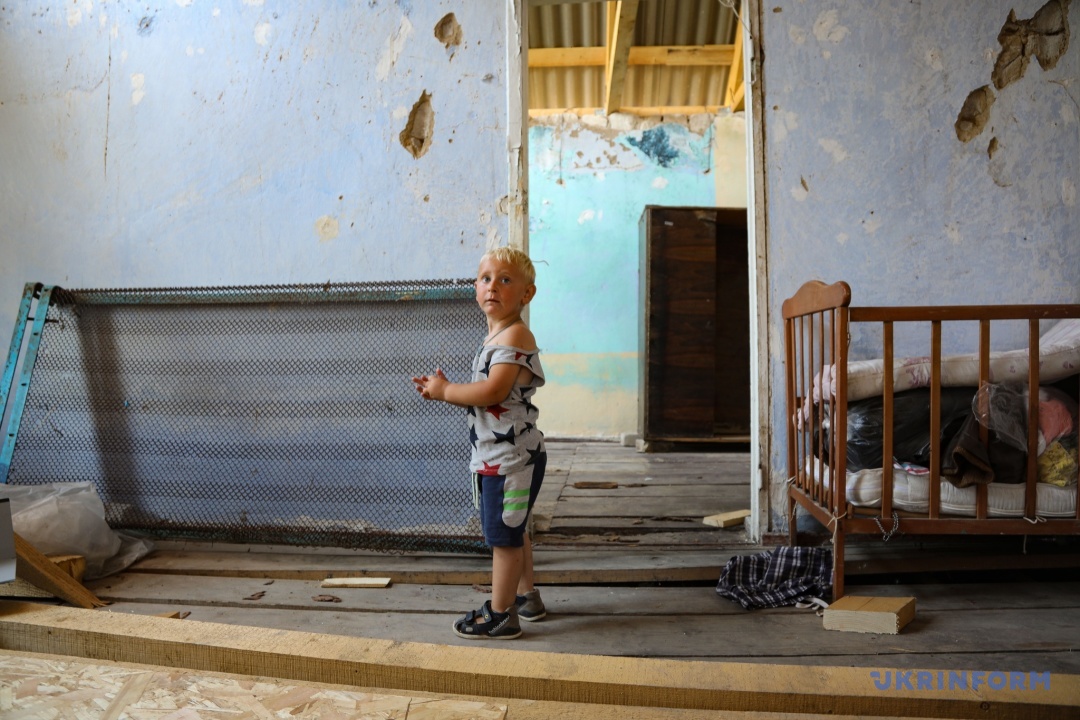
According to Viktoriia, she did not want to leave the village at all, even with fierce fighting taking place nearby. She and her son evacuated to Odesa as late as March 30, 2022.
“We were sitting in a neighbor’s cellar. My grandmother and uncle were with us. But on March 30, the neighbor was killed by shelling. Then my uncle made me leave. The kid had a hard time with the shelling. It’s quiet, but he’s scared to death of air raid sirens. When we returned, he was the only child here, and now there are twenty of them. You know, it was so scary when we came back! I thought, ‘Oh, my God, if you get sick, if you fall, no one will see. There were no people at all! They started coming back in the summer … We even have a shop in the village now. And there is a first- aid post. The village is gradually coming back to life. And what else do we have to do? Traveling around Europe? No. We belong here. When the war is over, we will rebuild everything. We are hard-working people, we are not afraid of hardships,” says Viktoriia.
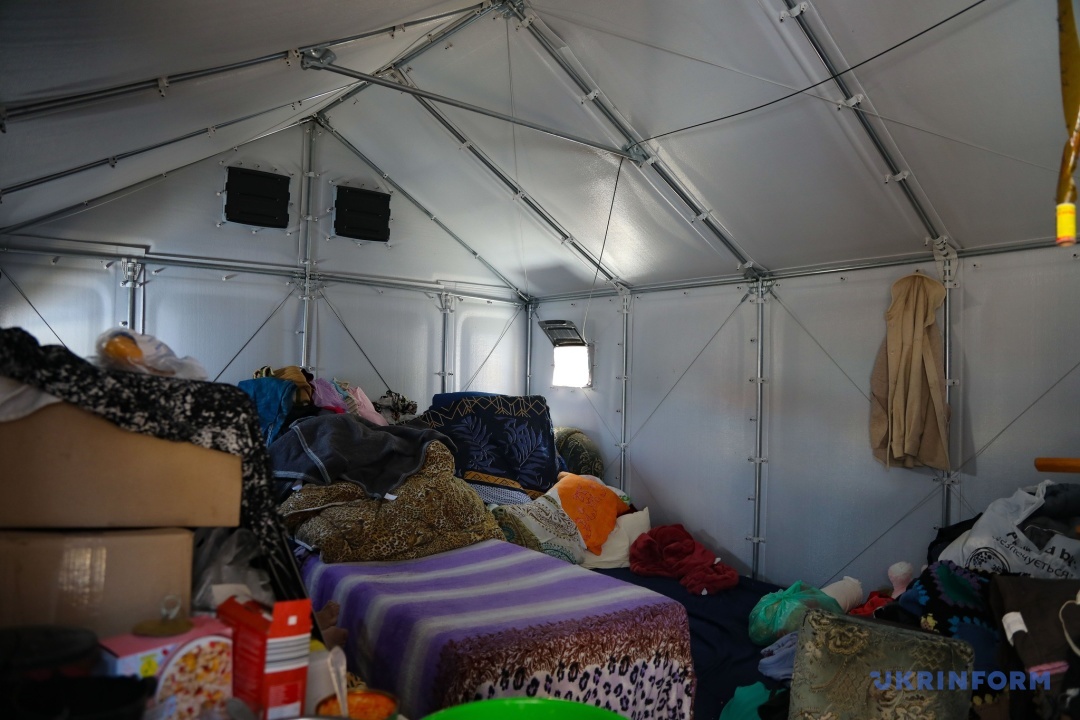
In the car, I say that it is hard to imagine how people would dare to live in such conditions. Upon hearing this, our “guide” Dmytro smiles and tells me to wait for half an hour: “You ain’t seen nothing yet. Wait till we reach Blahodatne.”
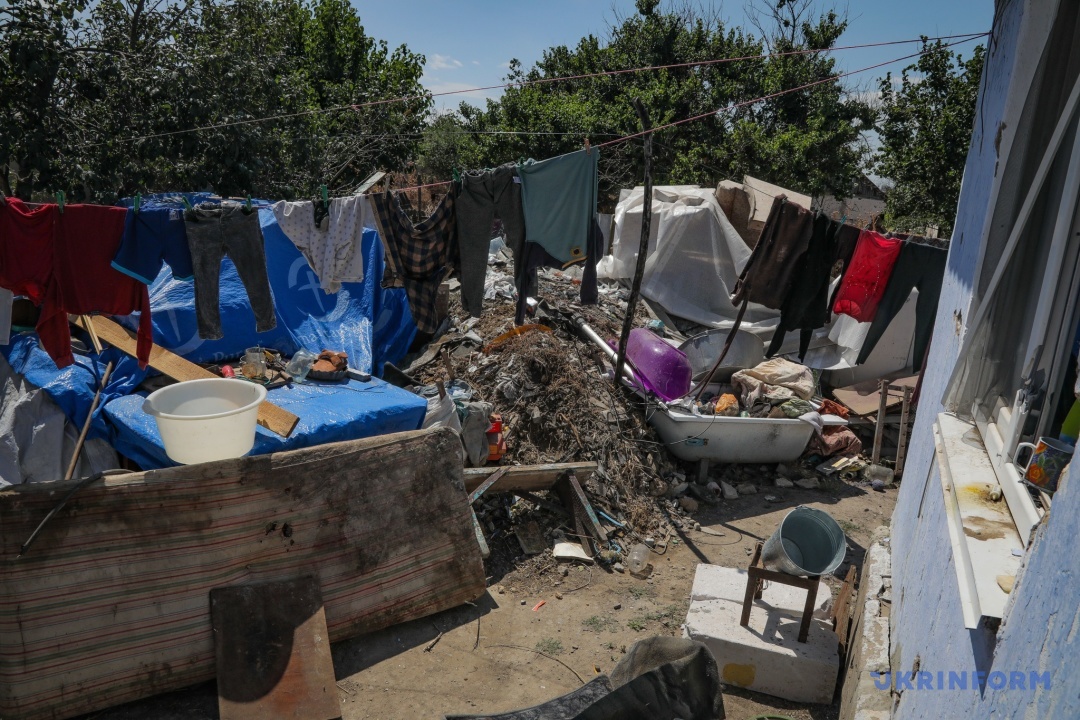
GRAVES, RUINS AND MINES
On the outskirts of Blahodatne we see a soldier’s grave. Dmytro says that the locals would themselves bury Ukrainian soldiers near the village.
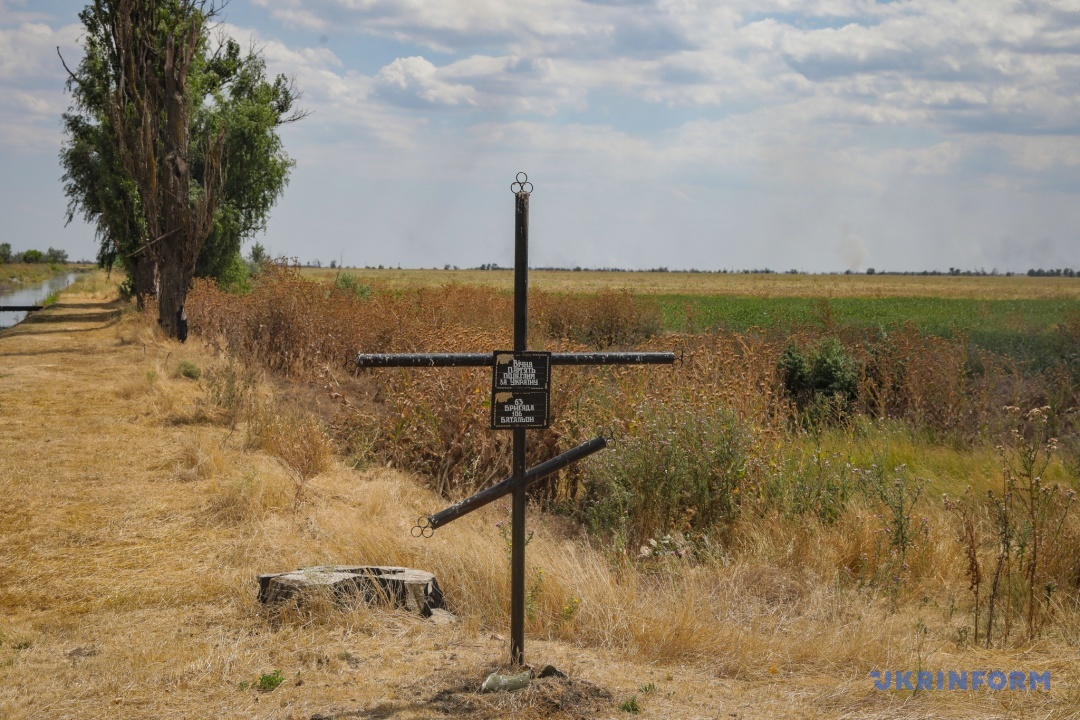
“We buried our dead home-folks right in the village. Under an apricot tree, under an apple tree… So that their family could exhume the remains and reinter them properly. The soldiers were buried outside the village,” explained Dmytro.
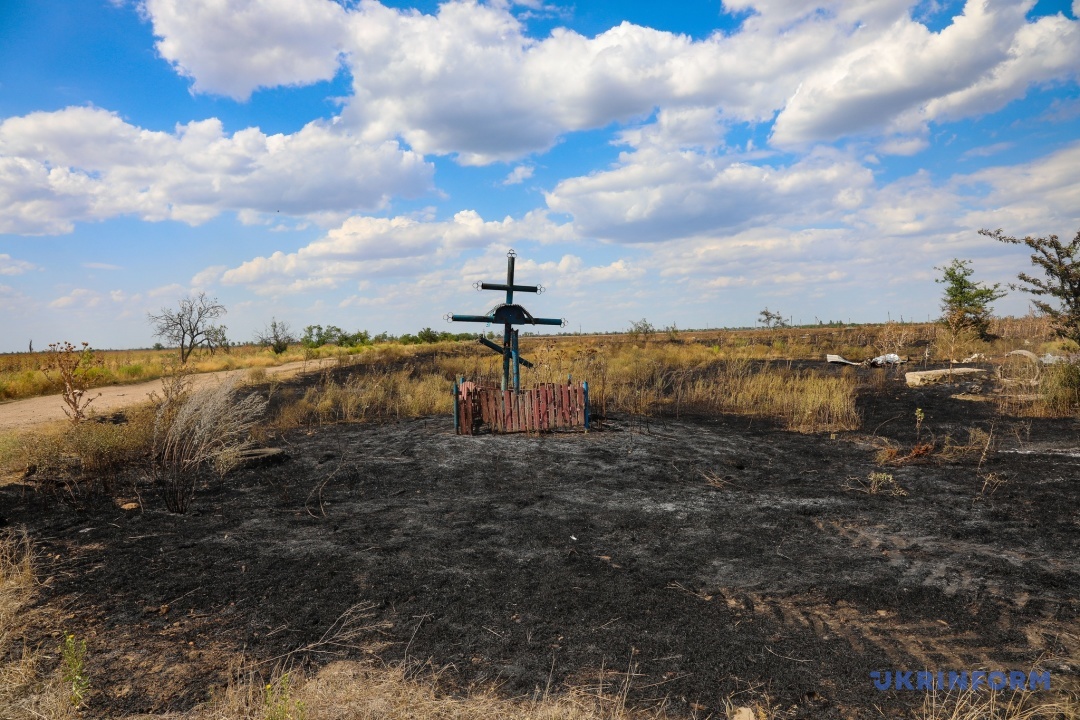
He asked us to stop for a minute and walked to the grave to put an apple on it. He said it was their tradition. Bowing his head, Dmytro thanked the fallen soldier for giving his life.
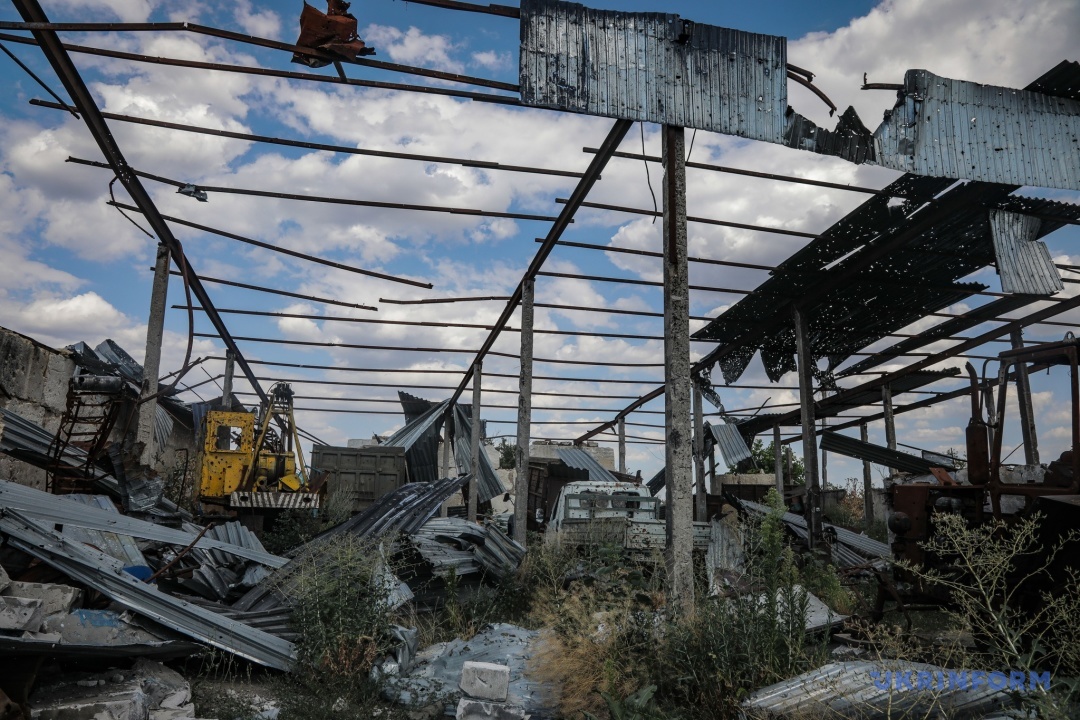
The first house we saw in Blahodatne belongs to Mykhailo Zveryshyn, a farmer we had just talked to in Partyzanske. We enter the kitchen garden and find human-sized weeds, fragments of building materials and personal belongings scattered all around. We go to the backyard, where the farmer had put up a granary and a shed holding agricultural machinery. Dmytro sternly insists that we follow his every footstep, because there may be unexploded explosive devices under the rubble. Black pebbles crunch underfoot; we look closely and realize that we are walking on burnt grain… Indeed, everything Mr. Zveryshyn had earned for half a century is ruined. Not a single stone is left of his house, and his machinery is completely destroyed.
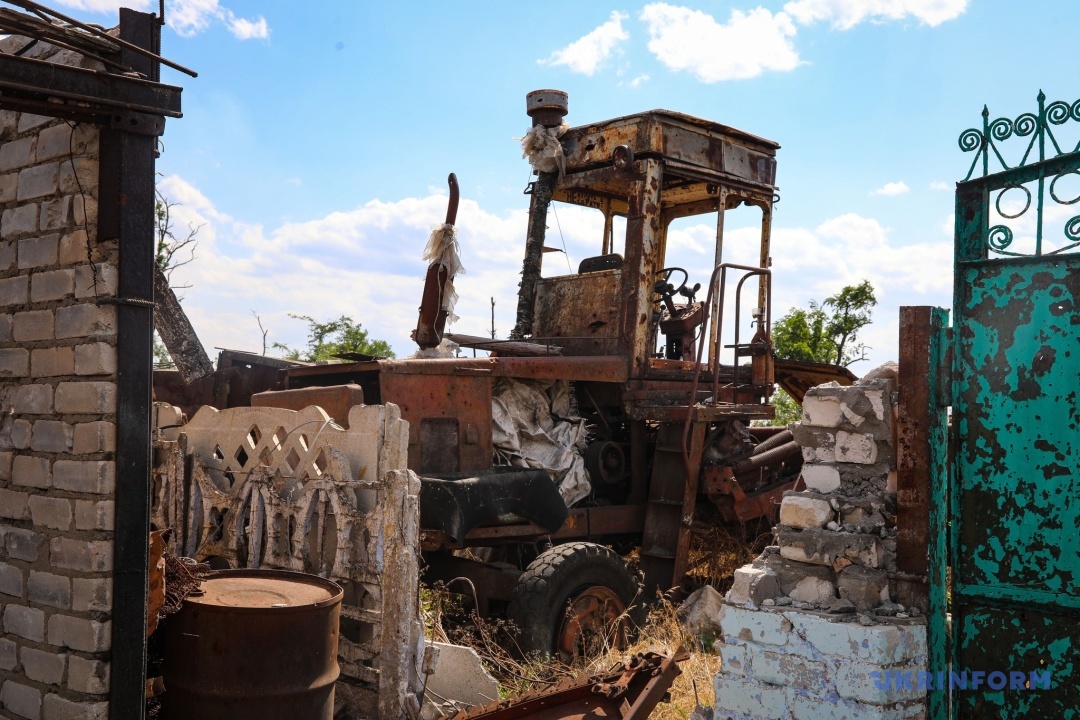
We take a walking “tour” of the village. Rocket fins are still sticking out of the cracked asphalt. Dmytro says that most of these “surprises” have already been removed by the locals, who started returning to the village late last November.
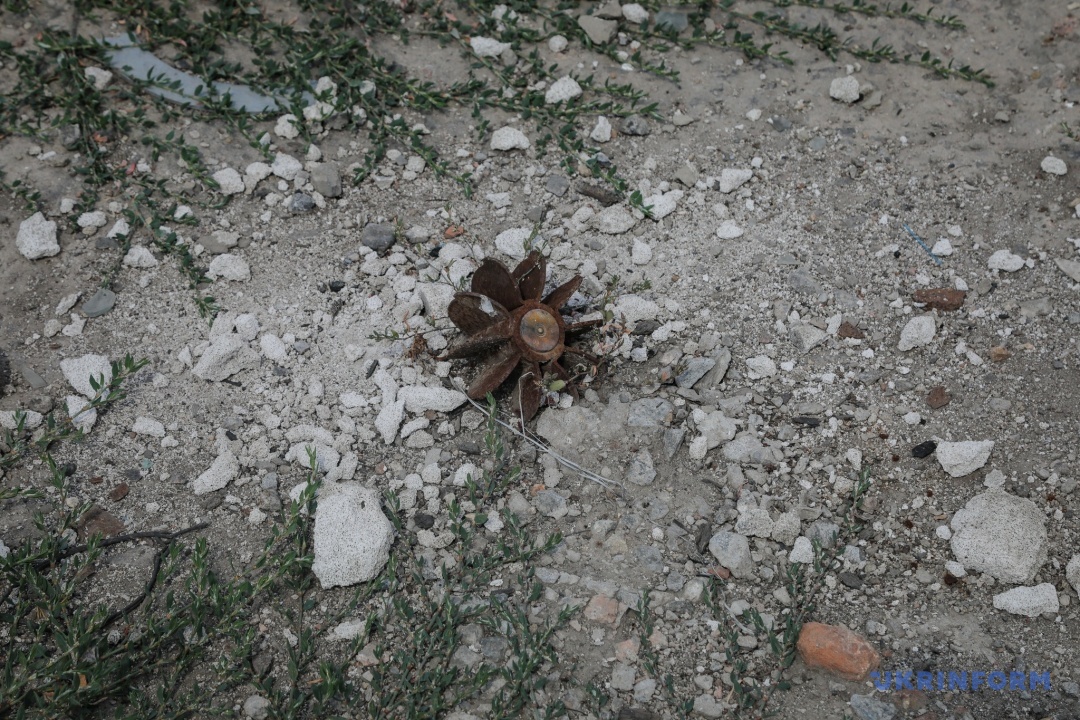
The first “Robinson Crusoes” that we saw were two men. They had nowhere to live, so decided to go back to the ruins of their own dwellings. They looked after the remnants of the machinery left by the farmers who had toiled the surrounding fields before the war, while the owners of the machinery brought them food. In the spring of 2023, about 40 residents came back to Blahodatne.
The hardest part, Dmytro says, is the lack of any help from the local authorities.
“Representatives of the consolidated community came, took selfies in front of the ruins and were gone. The houses even lack walls, and nothing can be restored. This can’t be helped with slate roofing or beams like the ones they haul to other villages. Our village is totally devastated. I get really annoyed when I watch TV reports about the restoration of Bucha or Irpin. Lots of well-to-do people lived there, and they can take care of themselves. It’s the opposite here. Naturally, I’m glad that people get help, but we are people too and need aid,” says Dmytro.
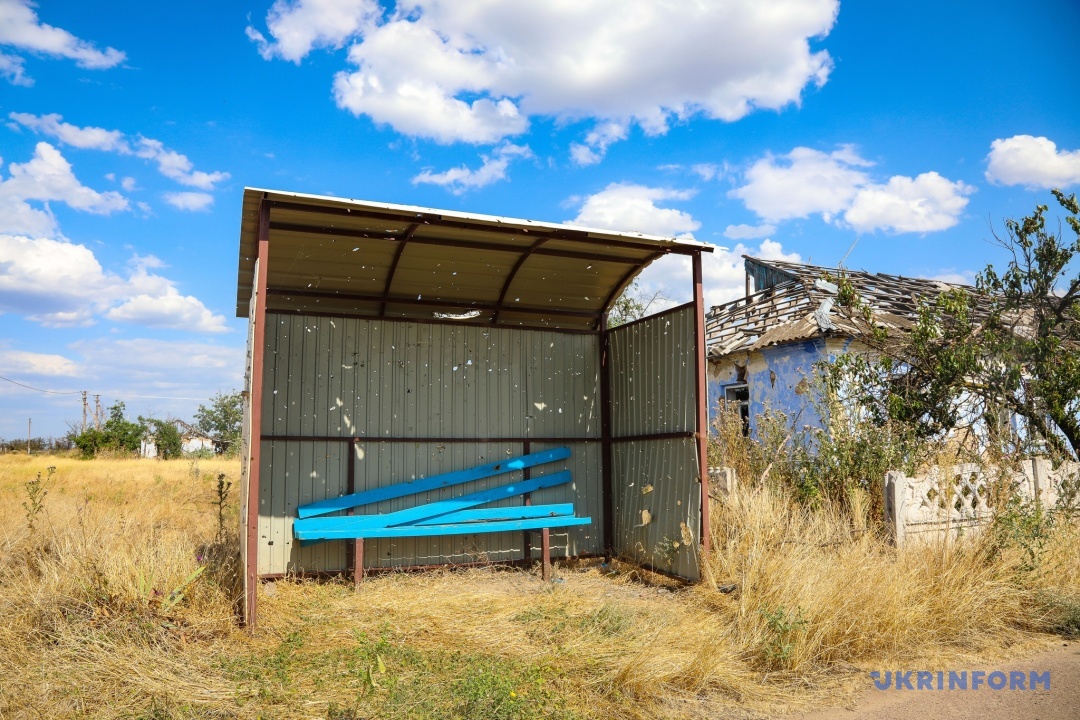
We pass a bus stop. The iron framework looks like a sieve now, speckled with bullet holes in the walls and ceiling. Before the war, a bus would take children from here to a school in a nearby village.
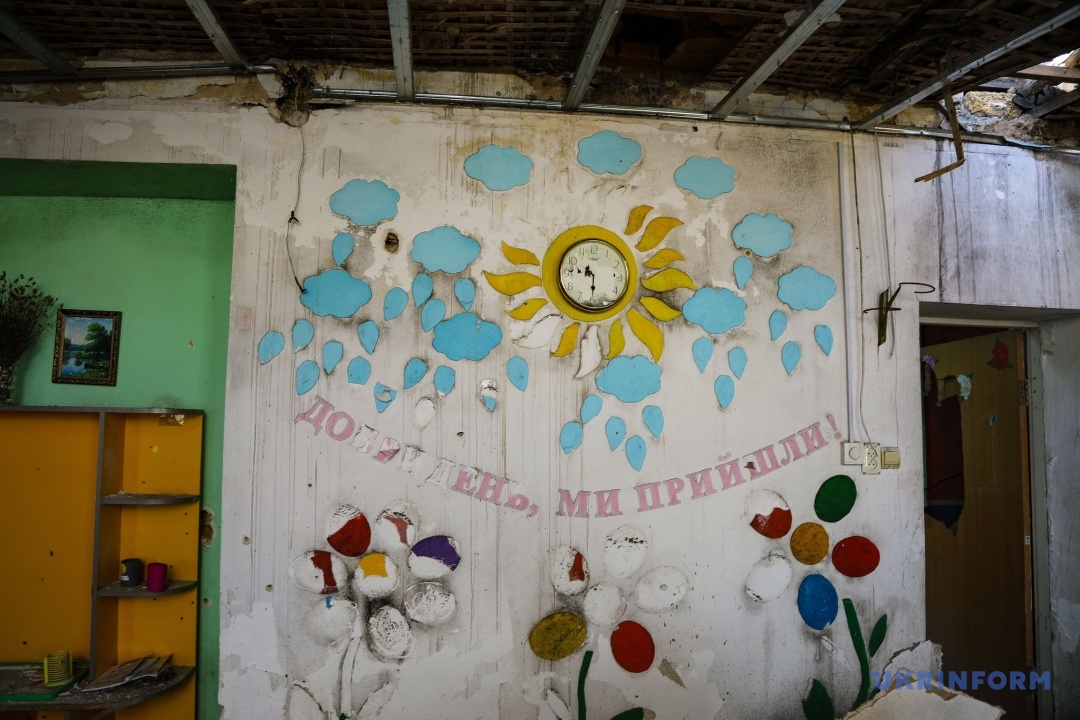
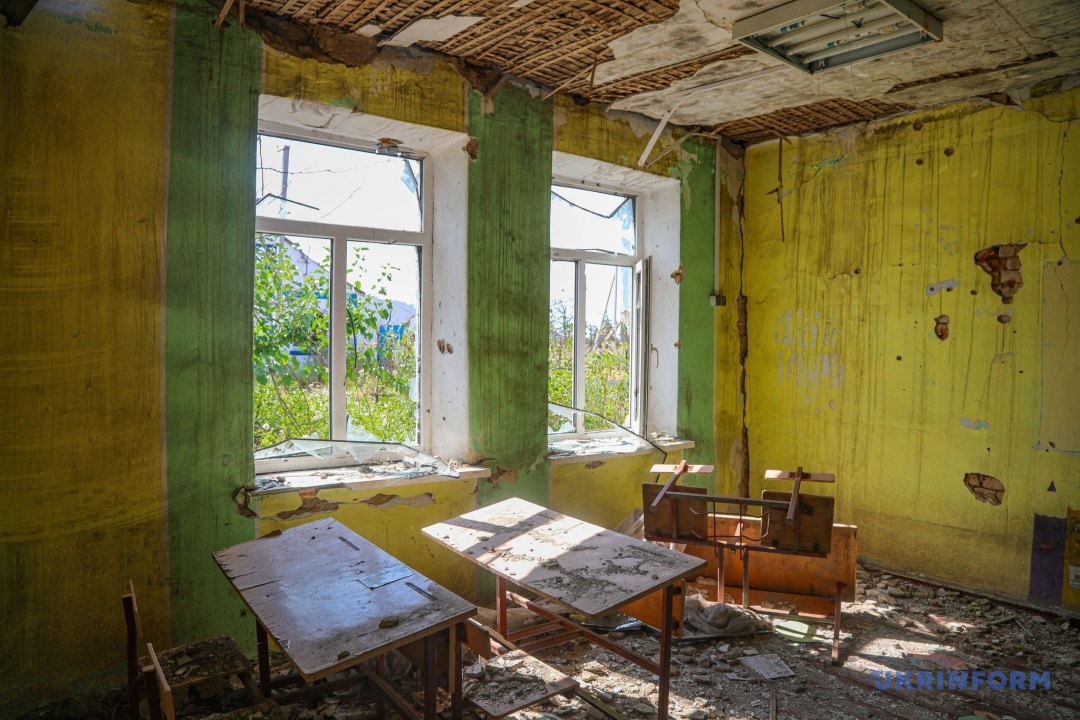
Blahodatne itself had only an elementary school that shared premises with a kindergarten.
We decide to take a glimpse inside this ruined facility as well. No roof, partially fallen walls, fragments of expensive furniture — this is how the facility where kids were taught looks like now. A rope still hangs above new wall bars in the former gym. The wall across has a huge hole in it. A box with CDs of classical music and fairy tales lies on the music room floor among the garbage. We venture farther into the bedroom and notice bathroom scales on the floor. Dmytro gives us a loud warning: “Stay away from it! It may contain a hidden explosive device left by the Russians.” We leave the premises very carefully, realizing that our guide was not joking.
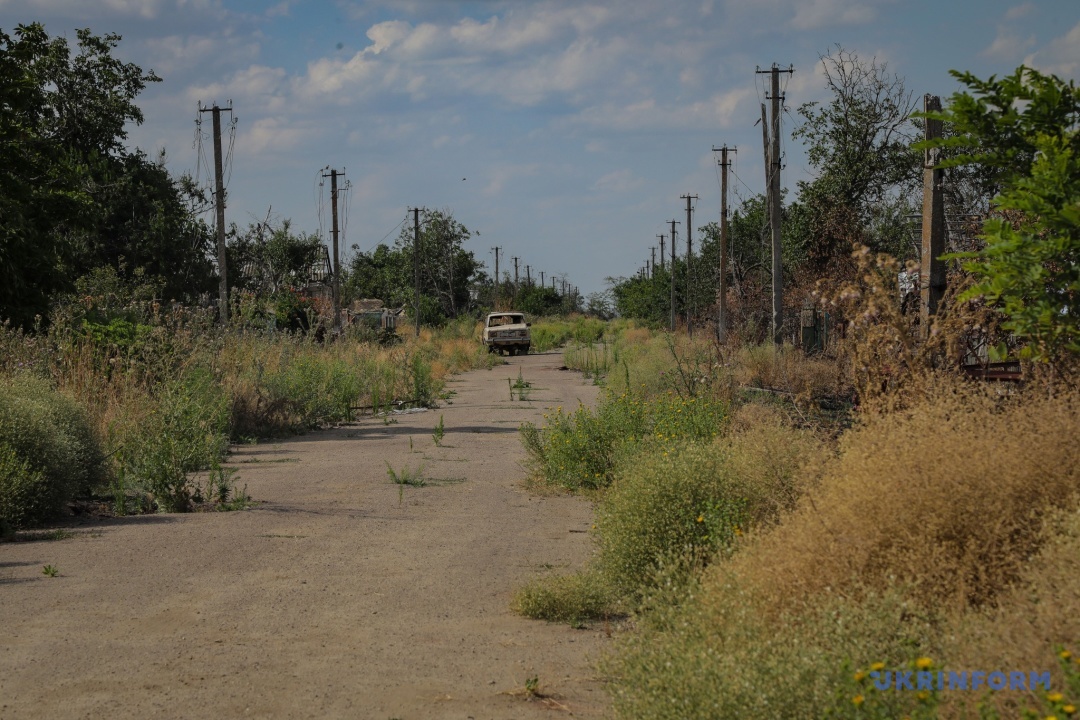
We walk through the streets of a ruined village. Although this is not our first “expedition” to front-line communities, we are horrified to see the scale of devastation, the likes of which we have never seen before.
I ask, “Dmytro, how can people live here?”
WE’D LIKE TO HAVE AT LEAST TWO ROOMS TO LIVE IN BEFORE I DIE
Dmytro takes us to the house of his aunt Svitlana. Together with her husband Oleksandr, she is trying to clear up her house. In the daytime, the retired spouses remove debris from the house and the land around. They spend nights in their car. We see today’s “finds”: shells laid out in a row along the fence.
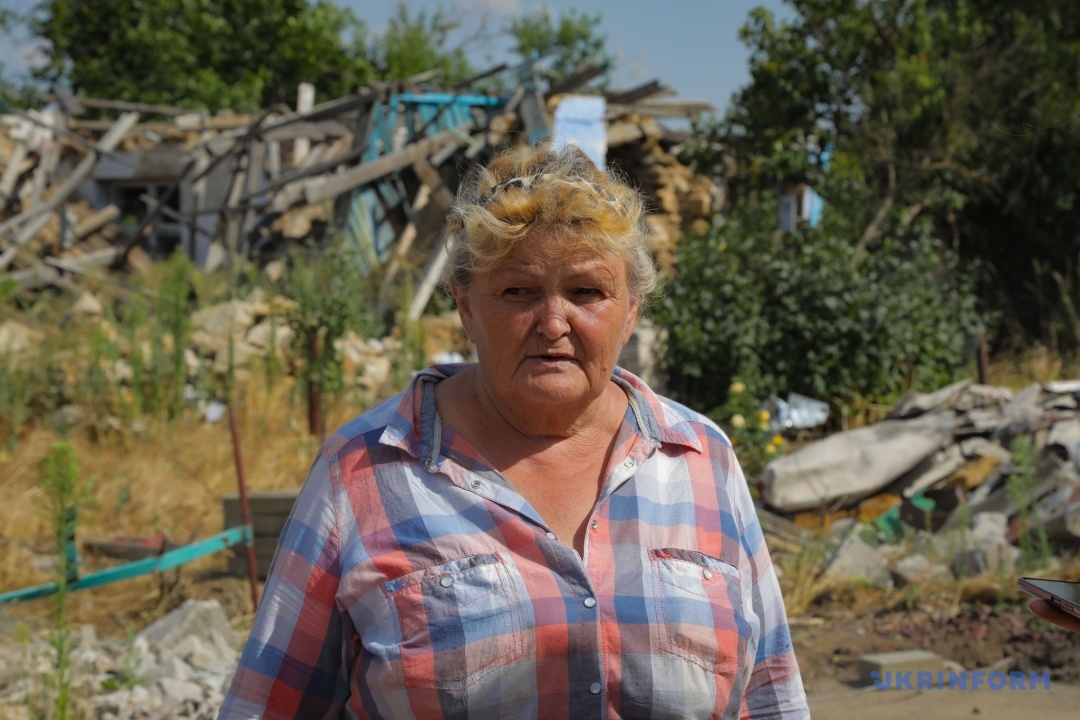
“I was clearing rubble near the chicken coop, lifted the door and saw this beauty lying over there! My arms and legs started trembling and I shouted, ‘Save me, Sashko!’ And he says, ‘What’s the big deal, no need for panic,’” Svitlana points to a shell.
Oleksandr boasts that, “for the press”, he would carry the shell away with his bare hands once again.
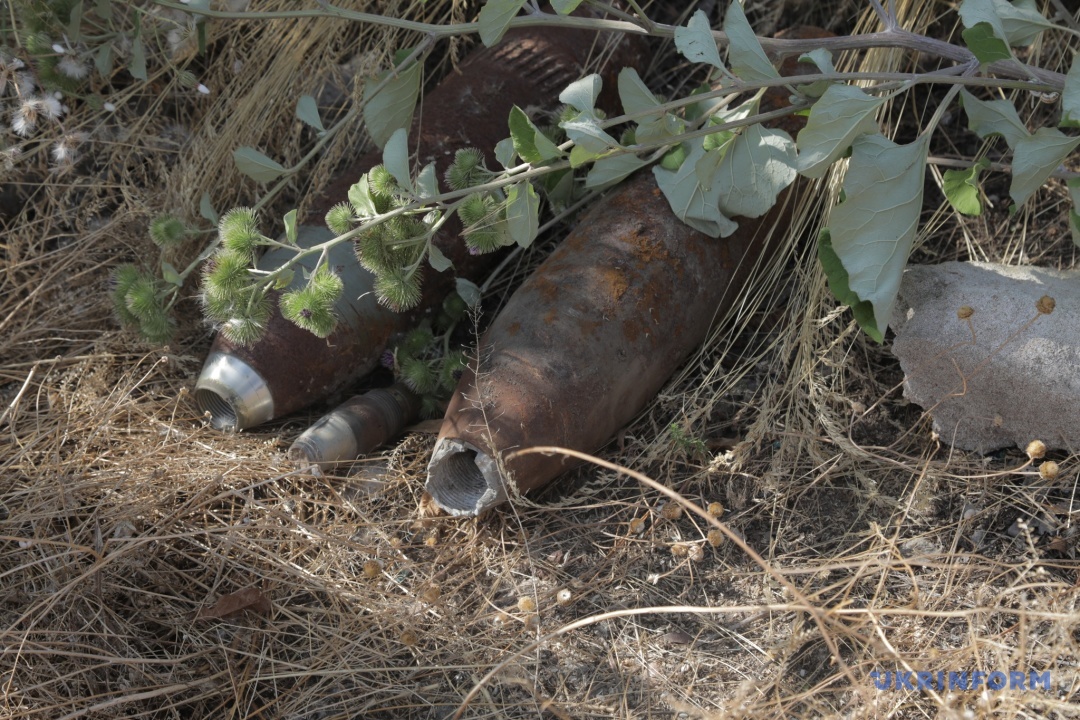
Just for the sake of a nice picture. He’s not sure, however, if this dangerous thing might explode. So, the two of us dissuade the daredevil from staging this show.
“We are clearing rubble ourselves. There’s nothing to wait for. It’s been eight months since the village was liberated, and nothing is being done. There is no demining! The village head told us that it would take five to six years to clear the village of mines and that no one would do anything until then. We were promised reconstruction under European standards, but everything is stalled. At least they could build us two rooms to live here! We’re retired, we can’t do it ourselves. Two rooms would be enough. Somewhere to live in before we die, we don’t need much! In Partyzanske, the locals are issued building materials if nothing else. But the situation is easier over there, roofs can be put up.
Here, there’s nothing left to put the roof above. Everything burned down. There’s not a single bowl or spoon left. And this is farmers’ village! We will not let it be destroyed. We were offered temporary housing in Partyzanske. But we don’t want to live there. We’ve filed an application for the restoration of our home. We filled out a statement of destroyed property. A committee will have to assess the damage to the house now. But when will this committee come? Many people in the village have no papers left at all, so they are unlikely to see any compensation,” says Svitlana.
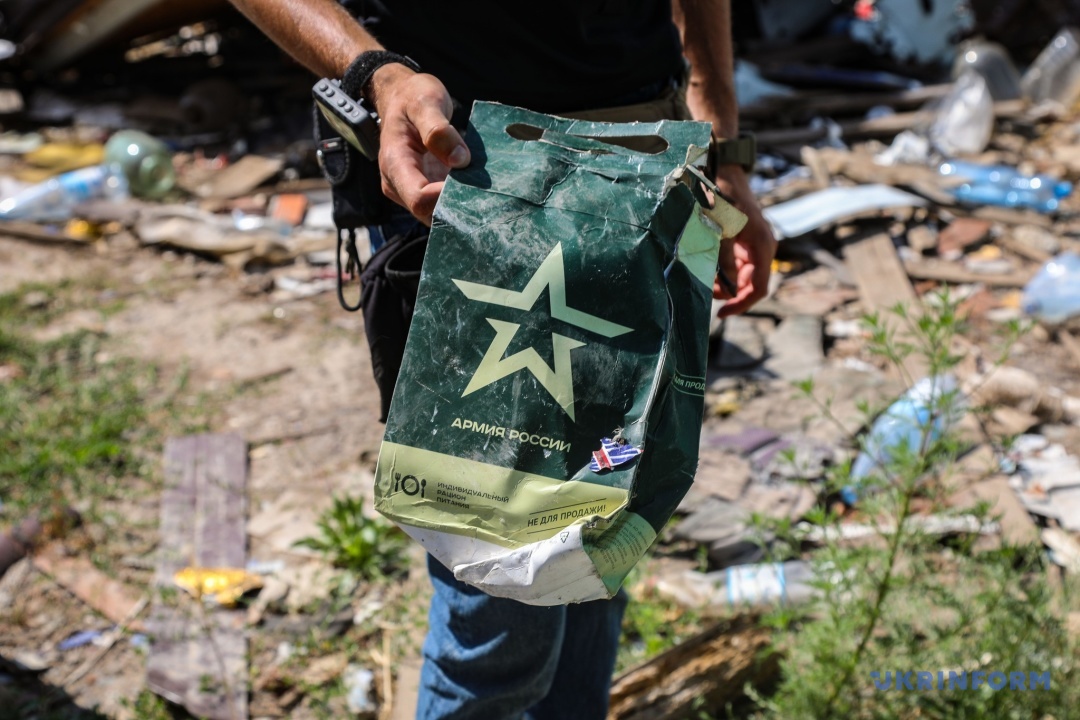
Together with her husband, she left the village early in April 2022. Svitlana suffers from asthma, and had to leave when she ran out of medicines.
“The Russians were stationed on the outskirts under the bridge. It was very scary. The shelling would start at six in the morning, like morning greetings. And more at midnight, as if to say good night. I would get up at four a.m. to milk the cows before the shelling started. Almost all the time we would sit in the cellar, all eight of us. My ten-year-old nephew was with us. A Ukrainian soldier came running to us one day and told us to lock up because the Russians had entered the village. We hid inside and were sitting quietly. We heard a tank approaching, then the door to the cellar swung open and the ‘orcs’ threw a brick inside. ‘Catch a grenade!’ We started screaming, let us out, we have children here! One Russian came down to the cellar and asked if there were any servicemen among us. Then they made all of us go outside for interrogation. They kept asking where the ‘nationalists’ were hiding. After learning nothing, they let us go back to the cellar. There shelling continued all through the night, we held icons and prayed. When we went out into the yard in the morning, the house was gone,” Svitlana recalls one of the last nights spent in the village.
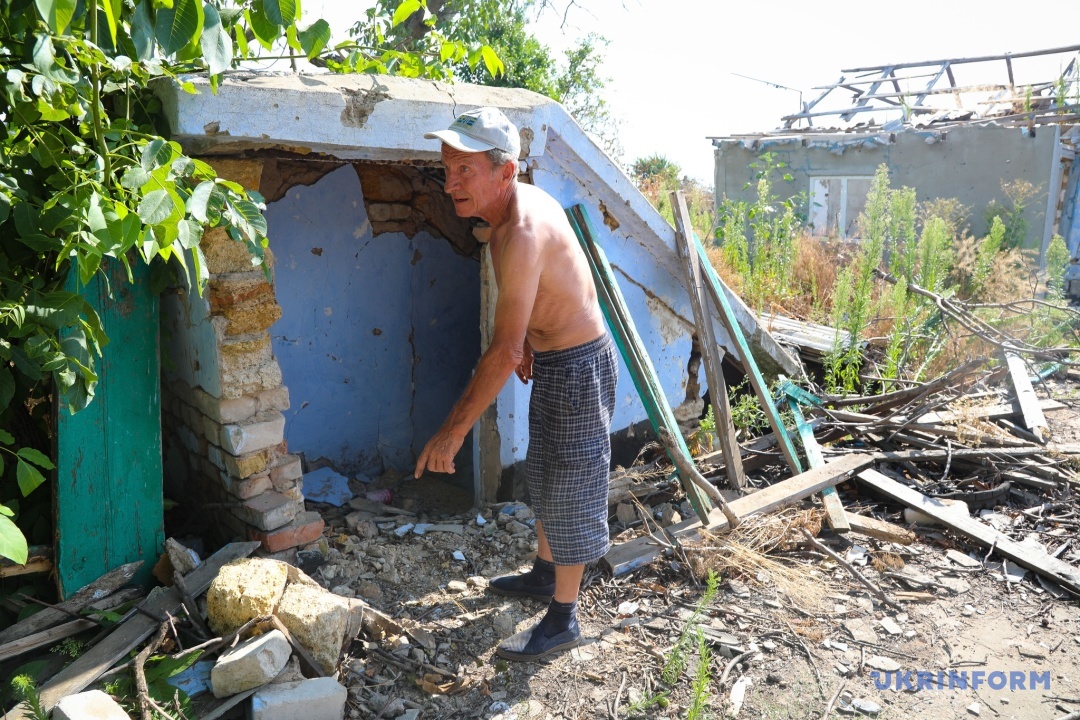
This is the cellar where the Russians threw a “grenade” and interrogated Svitlana and Oleksandr Svitlana and Oleksandr returned to Blahodatne in April 2023. They were issued a cot for a single person by the village council. The couple jokes that, perhaps, they will have to take turns to sleep.
“We can’t get humanitarian aid either, it’s as if we were begging. They told us to register on Facebook. Come on, I’m retired, I have no idea how to do that! Wouldn’t it be better to just call and tell us the time and place? Everything burned down, there’s not a single teacup or spoon, and we can’t buy anything. Sasha’s pension is 2,500, and I have no pension at all because I lack years of pensionable service. All our lives we’ve never asked for anything, relying only on ourselves. Now we don’t know what to hope for,” laments Svitlana.
While we talked, our guide Dmytro was scattering dry pet food near the houses. If no one helpspeople, who is there to care about the four-legged ones?
We say goodbye to Dmytro’s relatives and walk farther on to his house. He has once again brought a cat carrier with him, still hoping to find his cat that he could not take along when leaving the village.
“Please write about us so that we are not forgotten. We are left here to fend for ourselves. Help us,” we hear Svitlana’s parting words.
A MOUNTAIN OF DEBRIS AND A SCARECROW AS A SEMBLANCE OF LIFE
On our way to Dmytro’s house, we turn into another yard. This is where Uncle Viktor, Dmytro’s neighbor, is buried. His grave has slate and a self-made cross on top of it. The deceased had no family, so no one cares to exhume his remains for a civil burial. Dmytro puts another apple on his grave.
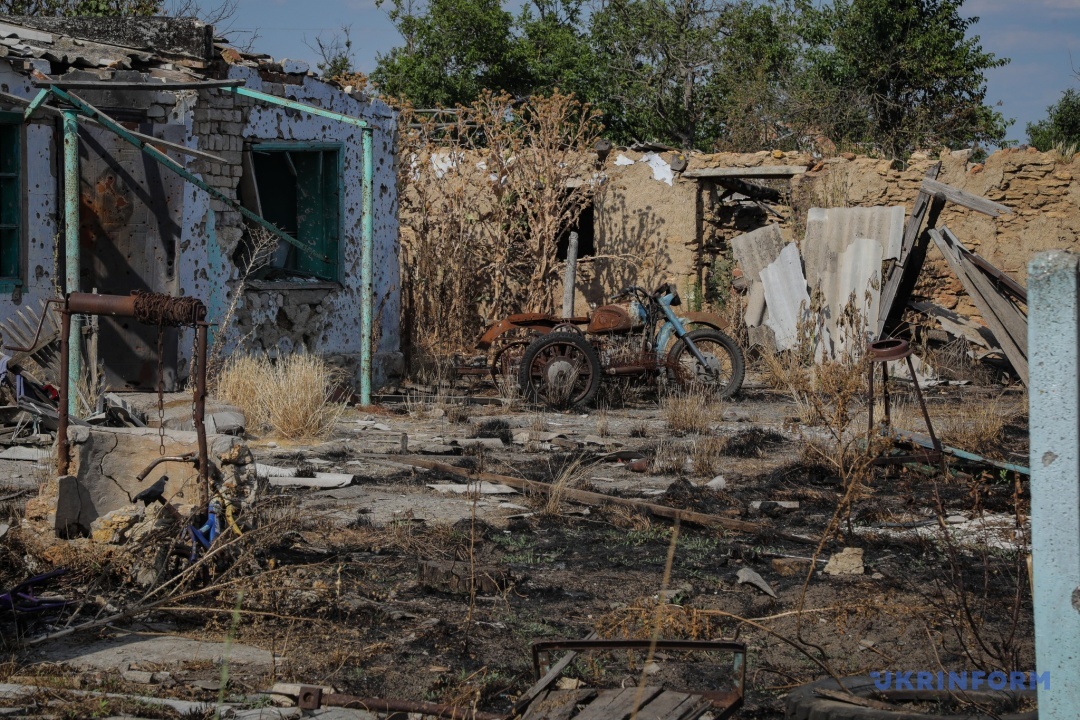
The yard where Uncle Viktor was killed near his cellar “He was hiding here together with other neighbors. The Ukrainian servicemen came over to help them evacuate. Uncle Viktor helped them carry an old lady to the car, and when he returned for her husband, a shell exploded close to him. That’s where he died. He was buried right on this spot. He was a good uncle,” says Dmytro with regret.
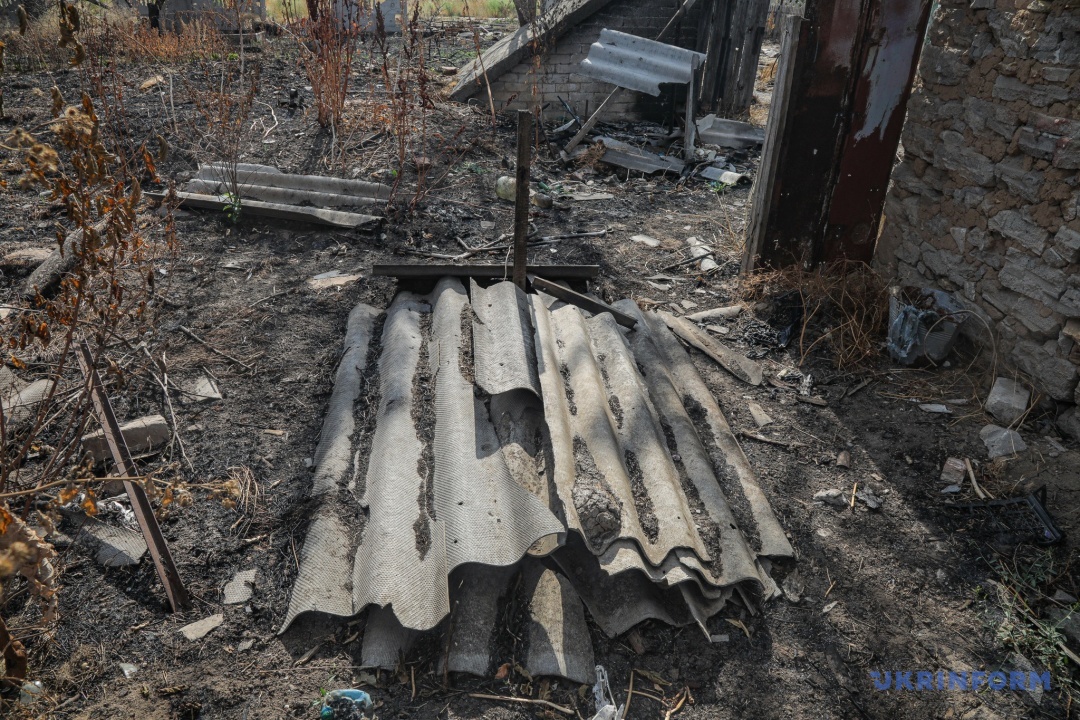
Dmytro’s house stands across the yard from Uncle Viktor’s house. A pile of debris is all that remains of it now. We see another line of shells exhibited in the front yard. Dmytro points to one of them, saying that it came from a Grad, while another — from an 80-mm MLRS.
Dmytro put up a self-made scarecrow at the entrance to the cellar. He says, it gives some semblance of life.
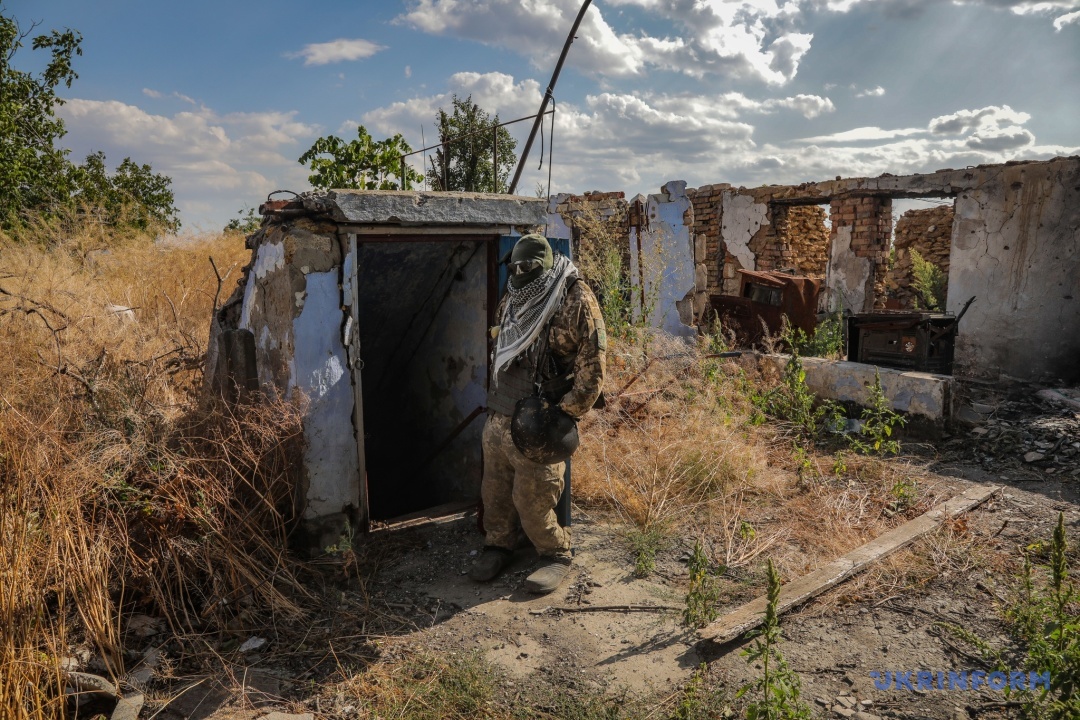
“I was among the first to return to the village. I was here, I saw the ruins of the house where I was born and raised. It was as if I were in a dream. Fortunately, my helmet was equipped with a camera, so I rewatched the video later, and it sank in fully for me. I’ve seen a lot of someone else’s grief, but there’s no way to express it when you feel it personally,” says Dmytro.
The prospect of restoring the house is unclear too. The house belonged to Dmytro’s late father, but Dmytro did not have time to re-register it.
“I’m not sure that my mother and I can count on anything,” says Dmytro sadly.
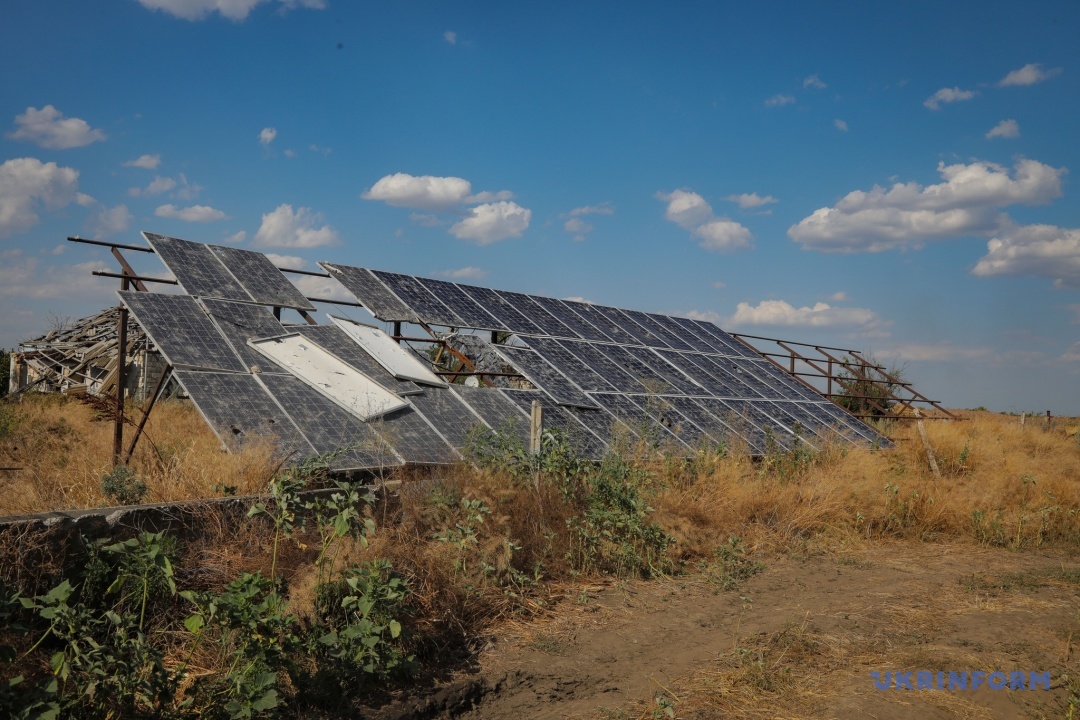
AT LEAST FIVE YEARS TO REBUILD
Distressed by what we saw and heard, we contacted Maksym Korovai, the Head of the Military Administration of the Pervomaisk Community that includes Blahodatne. We asked the official to clarify if the villagers were really offered to move to the areas previously occupied by pig farms, if any mine clearance was done in the village, and what Blahodatne was actually facing — its eventual destruction or reconstruction according to European standards.
According to Mr. Korovai, demining has been underway in the village since late November 2022. “EOD teams are working, conducting humanitarian demining. Norwegian People’s Aid, in particular HALO Trust, our local and oblast units of the State Emergency Service, units from other oblasts are all working to clear mines. First, the roads were cleared, followed by residential buildings and household plots in response to applications from the locals. If someone finds a shell in the kitchen garden or field, an application for demining is filed. A team arrives, the explosive ordnances get removed or disposed of on the spot,” says the Head of the Pervomaisk Military Administration.
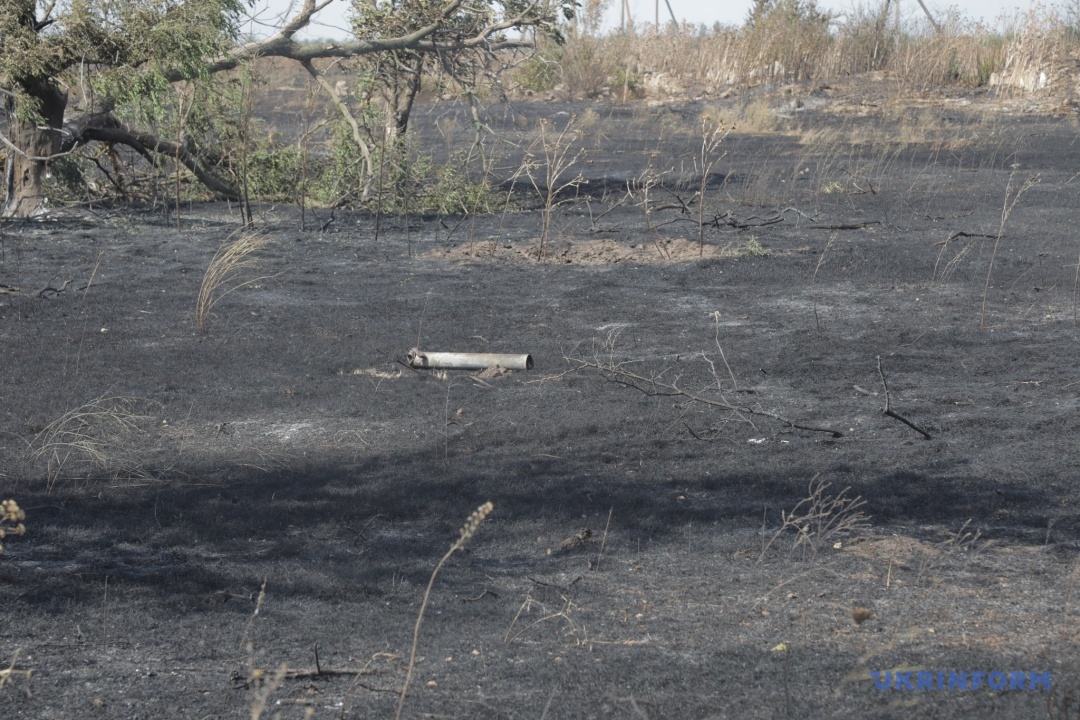
So far, 26 people have come back to the village, and, according to the official, 50 more intend to return before winter.
“As a military administration, we have enlisted the support of the Oblast Military Administration and are currently doing everything we can to speed up the mine clearance in Blahodatne, buildtemporary, eight-by-four-meter living quarters and fit them with small stoves by winter. We will provide residents with warm clothes, beds or cots, mattresses and blankets,” says Mr. Korovai.
Speaking of the suggested temporary housing development on the territory of former farms in Partyzanske for Blahodatne residents, the Head of the Administration explained that the soil in the area allocated for construction was being examined.
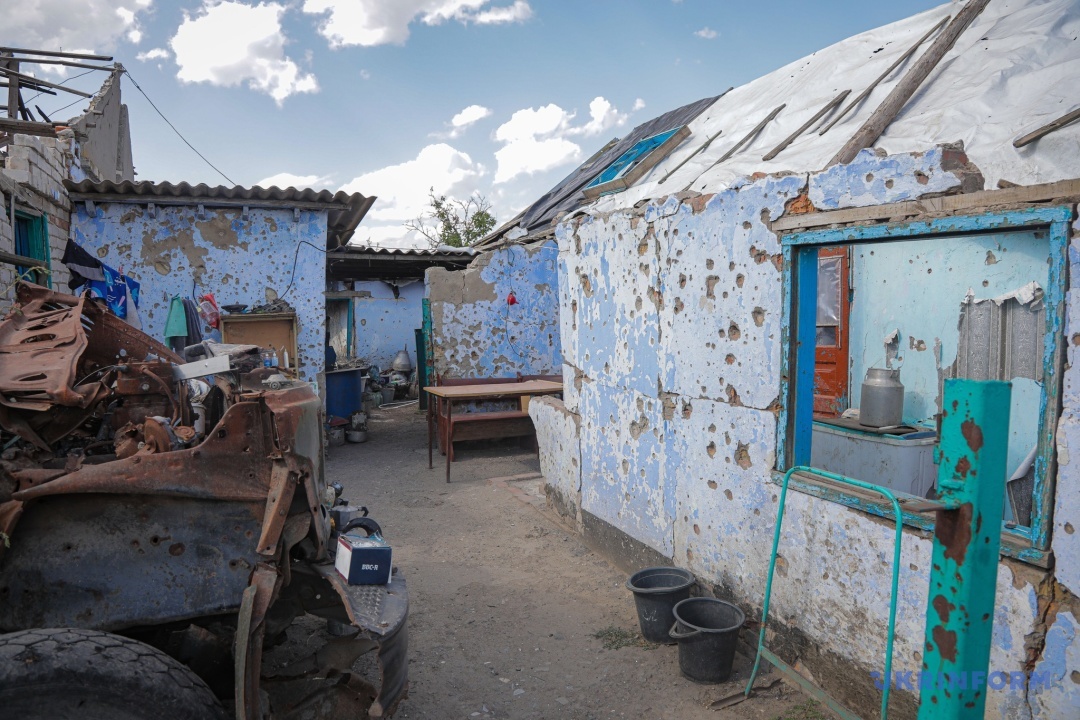
“I can’t think of any official or manager at any level who would assume the responsibility for building houses on a cemetery, so to speak. That’s why we are now conducting geodetic and geological investigations. Our partners are involved in the project. Of course, soil samples will be taken. If they fail to meet the requirements and if even the smallest risk to human life and health exists, then, naturally, no one would be forced to relocate,” Mr. Korovai stressed.
The official also added that the main reason why the people were reluctant to move to Partyzanske is that the majority of them were farmers with parcels of land leased to them in Blahodatne.
“That’s why I understand their angle perfectly well, along with the reasons behind their complaints against the military administration,” said Mr. Korovai.
He assures us that the village will never disappear. According to him, the project to rebuild the village is currently being discussed with the oblast military administration and international charities.
“My key mission is to preserve 11 inhabited localities in the district. I have no plans to destroy the village, because I myself come from there. Obviously, Blahodatne cannot be preserved in its pre-war shape. But we want to bring people, local businesses, and farmers back there as much as we can.
Although it will take time, at least five years,” said the official.
On an ending note, we would like to point out that most residents of Blahodatne are pensioners and may not have “at least five years” to live. Nevertheless, we are fully aware that the front-line still runs quite close to Blahodatne, and any talk about full reconstruction would be premature.
Hanna Bodrova, Odesa
Photos by Nina Liashonok
The report was written with the support of the Institute of Mass Information CSO, which implements the “Supporting Active Citizens Under Pressure in Ukraine” Project with the financial assistance from the European Union



